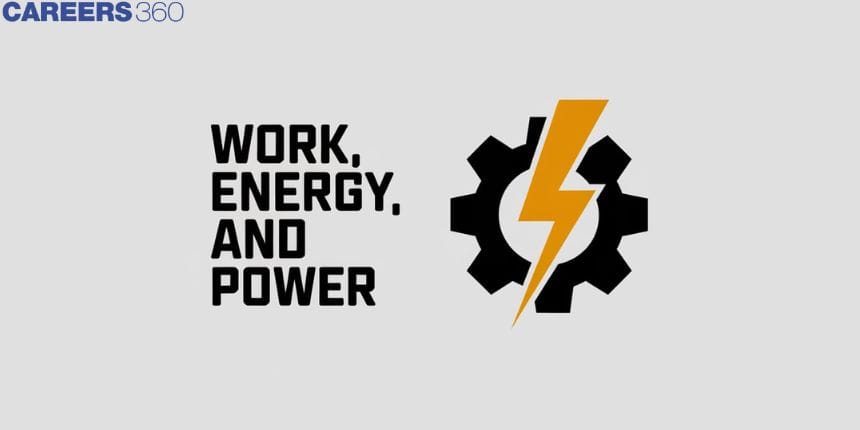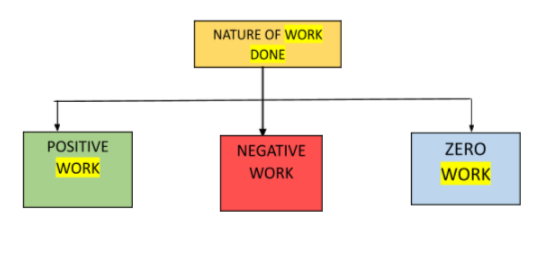Work, Energy and Power - Definition, Examples, Formula, Units, FAQs
In physics, power, work, and energy have almost the same meaning, which must not be confused with everyday meaning. Let us understand this concept of work, energy, and power with the help of an example: when we lift a box full of stuff, we get tired, and we need to eat food to get more energy. Thus, we can say that the work transfers energy. In this article we are going to learn the definition, SI unit, and dimensional formula of work, power, and energy and their characteristics.
This Story also Contains
- Work: Definition, SI unit, Dimension and Formula
- Energy: Definition, Dimension, Unit and Formula
- Power: Definition, Dimension, Unit and Formula

Work: Definition, SI unit, Dimension and Formula
Work Definition: Work is said to be done when the force acting on the body and the body moves through some distance in the direction of force.
This work is said to be done on a body if it satisfies the below two conditions:
1. A force must act on the body.
2. The object should move in the direction of force.
Work done Formula
Work formula Physics is given by
$W=F d \cos \theta$
Where F is the component of the force and d is the magnitude of displacement.
and $\cos \theta$ = angle between the force and displacement
SI unit of work or work done
Unit of work done = unit of force × unit of displacement
⇒ Unit of work done = Newton (N) × meter (m)
⇒ Unit of work done = N.m
The SI unit of work is the joule (J).
Dimensional formula of work done
Dimensional formula of work done = dimensional formula of force × dimensional formula of displacement
⇒ Dimensional formula of work done = $\left[M^1 L^1 T^{-2}\right]$ × $\left[M^0 L^1 T^0\right]$
⇒ Dimensional formula of work done = $\left[M^1 L^2 T^{-2}\right]$
Examples of work done
1. A man climbing the hills
2. A horse pulling the cart
3. A satellite orbiting the planet
4. Kicking the football
5. Pushing the table in the floor
Also read
- NCERT Solutions for Class 11 Physics
- NCERT Solutions for Class 12 Physics
- NCERT Solutions for All Subjects
Nature of the work done

Work done is a scalar quantity, and its magnitude may be positive, negative, or zero.
Positive work
When force is applied along with displacement, which are in the same direction, then the work done on the object is said to be positive work. For example, when a horse pulls the cart, the cart is displaced in the direction of the force applied.
Negative work
When the applied force and the displacement are in opposite directions, the work done on the body is said to be negative work. For example, when we apply brakes to a moving bicycle, the work done by the brake is negative because the braking force and the displacement act in opposite directions.
Zero work
When the body gets displaced along a direction perpendicular to the direction of applied force, then the work done on an object is said to be zero work. For example, the work done in pushing an immovable wall is zero because displacement of the wall is zero. So, work done is zero.
Energy: Definition, Dimension, Unit and Formula
Energy Definition: Energy of a body is defined as its capacity or ability to do work.
Energy is a scalar quantity.
Dimensional formula of energy
The dimensional formula for energy is the same as that of work done.
Dimensional formula of energy = dimensional formula of work done
⇒ Dimensional formula of energy = dimensional formula force × dimensional formula of displacement
⇒ Dimensional formula of energy = $\left[M^1 L^1 T^{-2}\right]$ × $\left[M^0 L^1 T^0\right]$
⇒ Dimensional formula of energy = $\left[M^1 L^2 T^{-2}\right]$
Energy Equation
Change in K.E. = Final K.E. – Initial K.E.
Some characteristics of Energy
- The entire mass/matter possesses energy.
- Energy can neither be created nor be destroyed; it always remains conserved.
- Energy can be stored and transferred from one form to another form.
- Some energy transfers or energy transformations can be seen, heard, or felt.
- The total quantity of the energy that exists in the universe is constant.
Several forms of energy
- Mechanical energy
- Sound energy
- Heat energy
- Thermal energy
- Light energy
- Nuclear energy
- Chemical energy
- Solar energy
- Magnetic energy
Related Topics Link, |
Mechanical Energy
The energy produced by mechanical means is called mechanical energy. Let discuss the two forms of mechanical energy:
Kinetic energy: The energy possessed by the body by virtue of its motion is called kinetic energy.
Kinetic energy formula physics:
$E_k=\frac{1}{2} m v^2$
Also, we can say that the kinetic energy of a body is equal to one-half the product of body mass along with the square of its velocity.
Example of kinetic energy: A bullet fired from a gun can hit the target on account of the kinetic energy of the bullet. Windmills work on the kinetic energy of the air. Ships sail using the kinetic energy of the wind. Watermills work on the kinetic energy of the water.
Potential Energy: The energy possessed by a body with principles of its position. Mathematically,
$\mathrm{PE}=\mathrm{mgh}$
For example, the potential energy of food is converted into electrochemical energy to operate our body system. Potential energy can be stored in an object by compressing it, stretching it, or bending it. When we stretch the bow and release it, the arrow goes forward with a large velocity on account of the potential energy of the stretched bow.
Work-energy and power Theorem for a constant force
Work-Energy Theorem Statement: According to this theorem, the work done on a body by the net force is equal to the change in kinetic energy of the body.
Proof of Work-Energy Theorem:
Suppose a constant force F acting on a body of mass m produces acceleration a in it. After covering distances, suppose the velocity of the body changes from u to v.
Use the equation of motion,
$v^2-u^2=2 \mathrm{as}$
Multiplying both side by 1/2m
$\frac{1}{2} m v^2-\frac{1}{2} m u^2=m a \mathrm{~S}$
By Newton’s second law,
F=ma
Therefore,
$\frac{1}{2} m v^2-\frac{1}{2} m u^2=\mathrm{Fs}=\mathrm{W}$
$\mathrm{K}_{\cdot} \mathrm{E}_{\cdot(f)}-\mathrm{K}_{\cdot} \mathrm{E}_{\cdot(i)}=\mathrm{W}$
Change in the kinetic energy of the body = work done on the body
Hence, the work-energy theorem proves for a constant force.
Also Read:
Power: Definition, Dimension, Unit and Formula
Power Definition: Power is outlined because of the rate of doing work.
$P=\frac{W}{t}$
Power is the scalar quantity.
SI unit of power
SI unit of power = SI unit of work/SI unit of time
⇒ SI unit of power = Joule / second
The Si unit of power is joule per second, i.e., $\mathrm{Js}^{-1}$
Dimensional formula of Power
$[P]=\frac{[\mathrm{W}]}{[\mathrm{t}]}$
$[P]=\frac{\left[\mathrm{L}^2 \mathrm{M}^1 \mathrm{~T}^{-2}\right]}{\left[\mathrm{L}^0 \mathrm{M}^0 \mathrm{~T}^1\right]}$
$[P]=\left[\mathrm{L}^2 \mathrm{M}^1 \mathrm{~T}^{-3}\right]$
The dimensinal formula for power is $[P]=\left[\mathrm{L}^2 \mathrm{M}^1 \mathrm{~T}^{-3}\right]$.
One watt: The ability of an agent is one watt if work done on the object is one joule per second.
One watt = (1 joule)/(1 second)
Instantaneous Power: The electric power at any instant of time is termed as instantaneous power.
Also check-
- NCERT Exemplar Class 11th Physics Solutions
- NCERT Exemplar Class 12th Physics Solutions
- NCERT Exemplar Solutions for All Subjects
NCERT Physics Notes:
Frequently Asked Questions (FAQs)
Work done is the product of force (vector) and displacement (vector). We don't focus on the direction of work done; we mainly focus on the amount of energy transferred during the work done.
There is no force without energy; without force there is no work done, and there will be no power without work done.
If the displacement is in the opposite direction of the applied force, then the work done will be negative.
Since, the displacement of the body is zero within the direction of force applied. Hence, work done is zero.
Zero work as a result of coolie is additionally applying force within the upward direction to adequate its weight so as to keep up balance. His displacement is in the horizontal direction. Therefore angle between force as well as displacement is ninety degrees therefore work done = Fs cos90 = zero.
One Watt: the ability of an agent is one watt if it will work on the object is one joule per second. One watt=(1 joule)/(1 second)
Work-Energy Theorem states that the work done by cyber web force performing on the body is adequate to the modification created within the mechanical energy of the body.
One joule of work is claimed to be done once a force of 1 Newton displaces a body through a distance of one meter in its own direction.